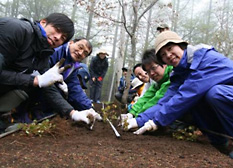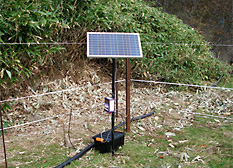Activity Report
Report on Activities from July 2011 to June 2012
One Year of Daikin Support for Shiretoko
Project to Restore Japanese Judas Trees and Life-Giving River
234-Meter-Long Sika Deer Fence Erected
In autumn 2011, as part of forest restoration work in an area along the Iwaobetsu River, a fence was erected so that the forest could grow and that Sika deer and other wild animals would not eat seedlings. Daikin employees were joined by many volunteers in successfully completing a fence 2.5-meters high and 234-meters long.
In May 2012, 316 seedlings that had sprouted from naturally falling seeds were uprooted and transplanted to a protected section of the forest. After transplanting the seedlings, volunteers maintained them by watering them every few days and removing nearby weeds. After a number of years of growth in the protected section, the young trees will be moved to the Sika-free section along the Iwaobetsu River.
 This fence allows seedlings to
grow free of Sika deer and other wild animals that may eat them.
This fence allows seedlings to
grow free of Sika deer and other wild animals that may eat them.
 Daikin volunteers replanted
Japanese Judas seedlings in a protected section of the forest.
Daikin volunteers replanted
Japanese Judas seedlings in a protected section of the forest.
Groundwork Completed for Returning Iwaobetsu River to Its Original State
Human beings have altered the flow of the river and built embankments along the lower section of the Iwaobetsu River. With the goal of returning the river to its natural state of river edges and meandering pattern and thus making it a suitable habitat for cherry salmon, char salt-water trout, and other fish to breed, in July 2011, staff of the Shiretoko Nature Foundation, Shari Town government employees, and local fishermen took a walk along the Iwaobetsu River to observe its state and discuss what could be done to restore it. Based on this meeting, a River Restoration Map was created by marking proposed restoration section and methods on an aerial photo of the area.
In January 2012, the River Advisor Meeting of the Shiretoko World Heritage Site Science Committee held a meeting. The event garnered a number of opinions: "I'd like to see biodiversity protection, not just a focus on beautiful scenery" and "To help prevent natural disasters, the entire river basin should be included in plans."
In June 2012, prior to improvement work on the river environment, a survey was carried out to determine things like the current river structure and the marine life in the river.
 Participants take a walk to
observe the state of the river firsthand.
Participants take a walk to
observe the state of the river firsthand.
 At the River Advisor Meeting,
experts exchanged opinions and advice.
At the River Advisor Meeting,
experts exchanged opinions and advice.
Project to Promote Human-Brown Bear Coexistence in Shiretoko
Fence Erected to Separate Humans and Brown Bears in Model District
In Rausu Town on the east of the Shiretoko Peninsula, hills rise up not far from the edge of the coastal road. The narrow plane along the road is where fishermen make their living, but brown bears are sometimes spotted in this area. To separate the habitats of humans and bears, a district was established in Rausu Town near the point of the peninsula, which included an area where kelp is dried. Here, a 750-meter-long fence with an electrical charge just strong enough to startle bears was erected and went into operation in November 2011.
This electric fence successfully gave humans and bears each their own habitat, and there were no longer bear sightings and damage from bears in the fishing port. The fence has also prevented Sika deer from going onto the road and near the kelp-drying area, thus making life easier for residents.
 Solar panels were installed to power the electric
fence.
Solar panels were installed to power the electric
fence. 
DNA Analysis Has Shown That Male Brown Bears Move Over a Wide Area
From the western-central part of the Shiretoko Peninsula, which includes the Rusha district of Shari Town, all the way to the peninsula tip, there are many brown bears but almost no human inhabitants. With the low mountains and narrow width of the peninsula at this point, brown bears were believed to be coming from the west side of the peninsula to the human-populated east coast of the Rusa district, although there was no proof of this. A survey on the bears' movement was thus carried out by analyzing DNA samples of their skin and hair, as well as by taking photos to identify individual bears.
As a result of a survey conducted between October and December 2011, it was determined that in the Rusa district alone there were 14 females and four males. DNA analysis showed that there were two main groups of brown bears in the Rusha district that came from the same mother, and that there were very few cases of females coming to this area from somewhere else. Meanwhile, it was determined that the males living on the east side of the peninsula were related to those in the Rusha district on the west wide, showing that the bears move over a wide territory.
 DNA analysis determined the location of the bears'
habitat.
DNA analysis determined the location of the bears'
habitat.Note: The photos on this website are courtesy of the Shiretoko Nature Foundation.








